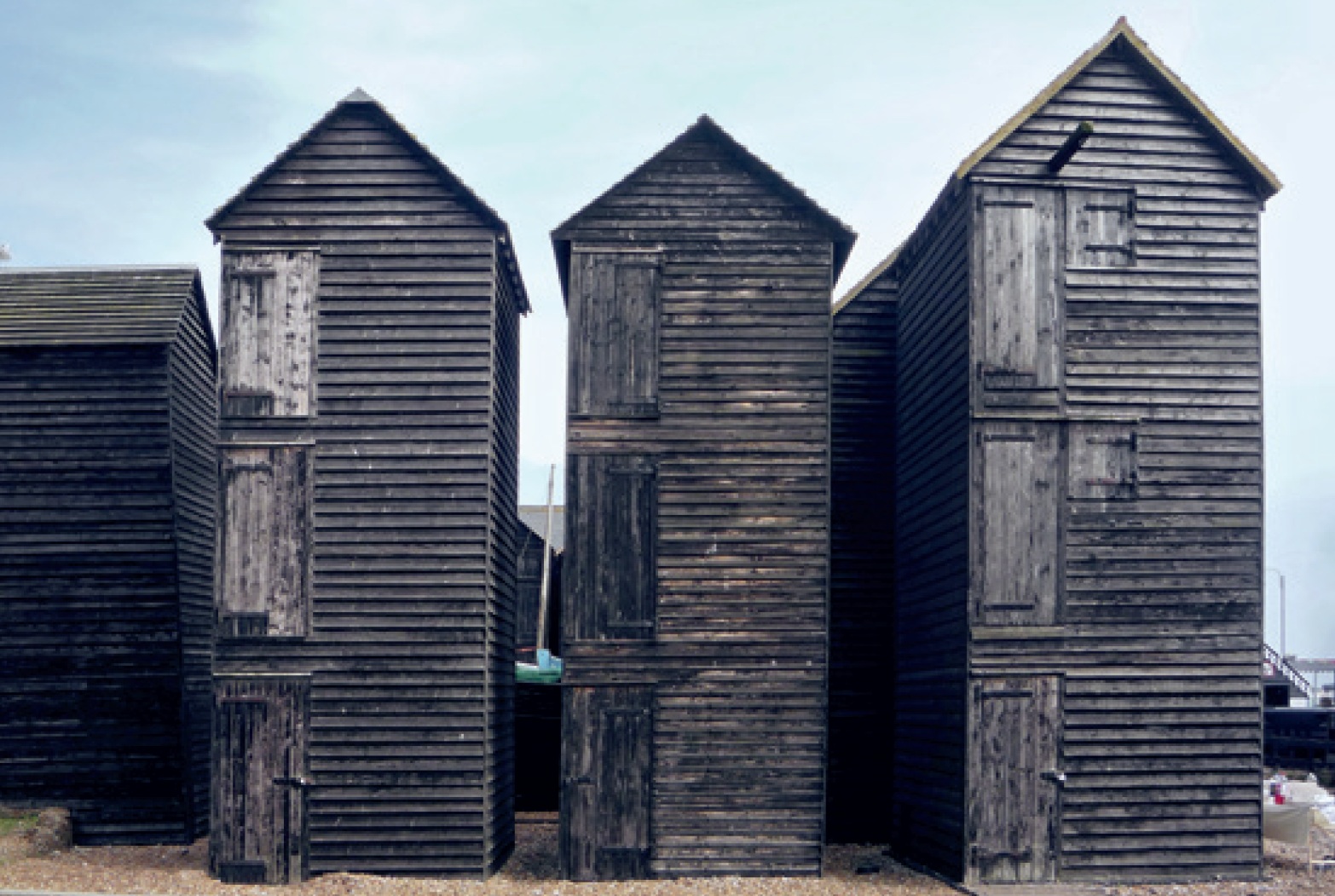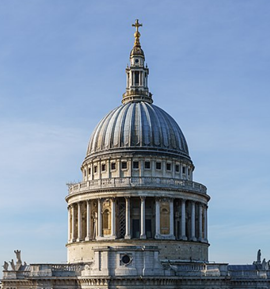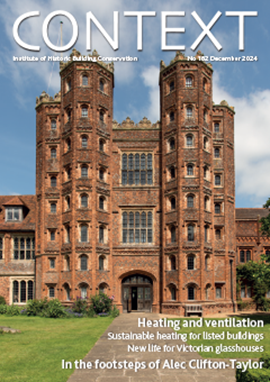The architectural use of wood and coal tar in England
New research for Historic England has helped to fill the gap in the long history of wood and coal tar being used as materials to preserve, waterproof and decorate buildings.

|
| Net and tackle stores on Hastings beach (Photo: Toby Crisford, Wikimedia). |
Wood and coal tar have long been valued as building materials for their preservative, waterproofing, adhesive and decorative properties. They are principally recognised as timber treatments but historically found diverse applications across various substrates. A keyword search of listed buildings in England returns 1,129 examples that include tar in the list description, and there will be many others where this material has not been explicitly identified, along with countless unlisted examples. Nevertheless, there has been limited research on the architectural use of tar and addressing this lacuna becomes more pressing as the heritage industry moves away from coal tar due to carcinogenic and environmental concerns. This article summarises a literature and archival review commissioned by Historic England on the architectural use of tar in England across history. It has been undertaken with the assistance of Michael Knights, a retired planning and historic building advisor, and leader of the Norfolk Wood Tar Project.[1]
Tar is a brown or black viscous liquid obtained from the destructive distillation of wood or coal. The chosen material is heated to a high temperature with limited oxygen to break the heavy hydrocarbons into smaller molecules, resulting in three main products: tar, gas and charcoal or coke. The terms ‘tar’ and ‘pitch’ are often used interchangeably, but the latter is made by reducing tar and has a considerably higher viscosity. Historically, pitch has been favoured as a building material due to its more solid and adhesive nature compared to unrefined tar. A vast number of chemicals can be extracted during the distillation of wood and coal, with a notable substance being creosote, a complex mix of chemicals contributing to the preservative properties of tar. Creosote has been distilled as a separate timber treatment since the 1830s.
References to tar and pitch rarely specify whether they derive from wood or coal. Those dated before around 1800 will relate to the former, and typically be made from Scots pine (Pinus sylvestris) due to its widespread distribution and high resin content, which resulted in a superior-quality tar. Pine tar is most commonly known as Stockholm or Archangel tar but many other names can be used to denote its origin. Following the introduction of coal tar in the late 18th century, it is frequently distinguished as common, vegetable or foreign tar. As these names suggest, wood tar was an imported product largely supplied by Scandinavia and the Baltic, with Sweden holding a monopoly in the early modern period (c1500–1800). These regions have a long tradition of making tar, whereas England lacked the necessary raw material to develop an industry.[2] The only native Scots pine in the British Isles is found in the Scottish Highlands, but its quality was perceived as poor and there is little indication of tar production.[3]
The architectural use of wood tar is well known in Nordic countries, with the medieval stave churches of Norway and Sweden representing some of the best examples of the tradition. In England, however, wood tar is principally recognised for its role in the building and maintenance of ships, with little attention paid to its architectural use. While the early history is vague, it is likely that the adoption of tar as a building material derived from the Nordic tradition, possibly in response to the introduction of pre-cut timber in the early medieval period. The overseas timber trade, well documented in medieval customs accounts, largely took the form of thin softwood boards used for weatherboarding, eaves boards, floorboards, guttering and doors.[4] Unlike hardwood, which needs no treatment in most situations, external softwood requires a protective coating like tar, limewash or linseed-oil paint. However, tarred oak examples are known from southern Norway, such as Høyjord Stave Church, suggesting that tarring could also be a decorative custom.[5]
Medieval building accounts provide the earliest known documentary evidence for the architectural use of tar in England and reveal some unexpected applications. Pitch is commonly described as a material for making cement that could be used for waterproofing, such as in the construction of the cistern at Westminster Palace in 1259,[6] or as an adhesive to join masonry (possibly creating a damp proof course), as seen in the cloisters of Norwich Cathedral in 1336.[7] No direct association with timber has been found in the accounts but it is notable that most purchases have no specified use. For instance, during the construction of Exeter Cathedral, pitch was bought on 26 occasions between 1299–1353, with 16 unspecified purchases, nine for cement and one for plumbing. [8] Pitch was also used to darken ironwork, as noted at Windsor Castle in 1352,[9] and it is possible this was the intention of the earliest known reference to pitch for gate hinges at Dover Castle in 1227.[10]
The medieval building accounts demonstrate that tar was commonly used during the construction of monumental and elite architecture but it is unknown if it appeared in ordinary buildings in this period. Presently, the earliest known evidence comes from contemporary accounts of the Great Fire of London in 1666, which, according to The London Gazette, spread rapidly because it started in an area ‘so close built with wooden pitched houses.’[11] This observation is echoed by an eyewitness, who stated that it was ‘a closely built district, and most of the houses were of wood, some being coated with pitch and others with plaster.’[12] These buildings were likely clad with weatherboarding, which was common in London before the fire, as demonstrated by the Hollar panorama of 1647. Pudding Lane was not a wealthy street, being largely occupied by tradespeople in rented houses, yet pitch was clearly an affordable coating for landlords and presumably tenants on repairing leases.
References to tar are sporadic throughout the early modern period but it may be that the material was common enough to not be worth writing about. For instance, a builder’s dictionary of 1736 states only that pitch is ‘well known both for Quality and Uses’ – essentially, it needed no explanation.[13] The use of tar appears to have been less ubiquitous, with the same source describing it as ‘a Sort of liquid Pitch, useful to preserve Weather-boards’. There are some references to agricultural buildings, with a lease for a farm in Bedfordshire mentioning a ‘pitched stable’ in 1686[14], a ‘well pitched’ cow house in Devon in 1756[15] and two ‘weatherboarded, tarred and well thatched’ barns in Suffolk in 1782[16]. Moreover, tar-coated industrial buildings appear to have been common enough in London to warrant prohibition under the Building Act 1774 as a fire hazard.
One of the more curious uses of tar was as a waterproofing agent for paper roofs, which appear to have been widespread in parts of England and Scotland during the 18th and 19th centuries, particularly around papermills.[17] This practice may have had earlier origins, as another eyewitness account of the Great Fire of London mentions that when the fire reached Thames Street it met ‘with nothing by the way but old paper buildings’.[18] The use of paper allowed for a nearly flat roof, which sparked a minor trend among members of the upper class who admired their picturesque appearance. Eminent architects John Carr and John Nash were familiar with the process, with the latter adding paper roofs to numerous country houses and royal residences, most notably the Brighton Pavilion and Buckingham Palace.[19] However, such roofs likewise appeared on more modest buildings, such as factories and workers’ housing, and were later also waterproofed with coal tar.
The importance of tar for shipbuilding and maintenance grew as England became a maritime power in the late 16th century, leading to some anxiety in supplying the naval and merchant fleets.[20] In an attempt to subvert the Swedish monopoly, tar production was encouraged in the North American colonies from 1696 but this ultimately failed to provide an alternative source.[21] At the same time, numerous individuals were experimenting with methods to extract tar from coal, with Scottish inventor and impoverished nobleman Archibald Cochrane, 9th Earl of Dundonald, being the first to devise a commercially viable method, for which he was granted a patent in 1781. The enterprise should have been hugely successful, but the viability of coal tar at this time was dependent on securing a Royal Navy contract that did not materialise, as the entire fleet had recently been copper sheathed at great expense in response to the American Revolutionary War.
Lord Dundonald developed coal tar for use in shipbuilding and maintenance but he envisioned that it could be adapted ‘to all sorts of woodwork exposed to air or water’, such as fencing or shingle roofs.[22] From the beginning, its use mirrored that of wood tar, with one early review suggesting it may likewise ‘be used for doing over houses that are built of porous stone.’[23] At first, coal tar appears to have been more greatly appreciated in Scotland, with another review claiming it as ‘the best preservative ever invented for Field Gates, Paling, Pickets, ends of Joists and Rafters in the roofs of New Houses.’[24] By 1790, Lord Dundonald had established a shop in London. An English review of the same year claimed that coal tar prevented the expansion and contraction of wood ‘which is too frequently the Case with Post Mills, Sheds, and other Wooden Erections.’[25]
Despite many favourable reviews, Lord Dundonald did not achieve commercial success before his patent expired in 1795 and it was only with the establishment of the manufactured gas industry that coal tar became widely available. The first public gasworks opened in London in 1813 and quickly spread nationwide to supply light and heating.[26] Coal tar was a by-product of this industry but the gasworks struggled to sell it in the early years and it was often dumped in rivers. Even into the 1840s, coal tar appears to have been something of a novelty, with letter writers to the architectural journal The Builder often wanting advice for how to use the substance, or sharing their experiments. The problem of disposal ended only in the 1850s, when it was discovered that various chemicals could be extracted from coal tar, playing a leading role in the development of the synthetic dye and drug industries.
From this time, coal tar became something of a wonder material and was used extensively in many industries, including building construction. This was helped by its relatively low price and the fact that it was perceived as highly durable because it dried harder than wood tar.[27] Nevertheless, the latter continued to be used and was not a niche product, appearing in a list of common building materials printed in The Builder from 1885 onwards. Wood tar had a more agreeable smell and was likely preferred for indoor work, such as laying parquet floors[28] and damp proofing beneath plaster.[29] However, it also continued to be used externally, particularly to colour the half-timber work of Tudor Revival architecture.[30] Compositions of wood and coal tar were also common for flooring and roofs, suggesting they were valued for different properties.[31]
Few list entry descriptions specify the type of tar but it is likely that coal tar is used in most of the buildings identified due to its widespread adoption in the mid-19th century. When plotted on a map, the 1,129 buildings are mainly distributed across the south and east of England, with the greatest concentrations in the South East and East regions. The London metropolitan area stands out as an anomaly, due to the loss of timber-framed and clad buildings in the Great Fire, subsequent laws prohibiting their construction and the continual pressures of redevelopment. Overall, the data suggests that tarring was a diverse practice, encompassing various building types, ages and social classes. The substrate is the main factor dictating the use of tar, and the results thus conform to regional patterns for material use.
Weatherboarding has by far the greatest representation, particularly for agricultural buildings and coal-tar coatings may recall an earlier tradition of using wood tar. The second largest group are tarred roofs, which are mainly slate, but with two paper examples in Oxfordshire. The concentration in the west country reflects the adaptation of an earlier repair technique called ‘slurrying’ or ‘grouting’, which prolonged the life of a failing slate roof by covering it with lime mortar. Brick is also prevalent and most of the results are 19th-century tower windmills, with coal-tar coatings likely employed to stop water leaking through the mortar joints of sloping walls. This may also reflect a regional trend, as coal tar is not used on windmills in the west of England. The last significant group is tarred plinths, which are commonly seen on timber-framed and earth buildings. These are underrepresented in the data and it may be because of their ubiquity that they are often not recorded during listing inspections.
Some substrates have few results and are likewise underrepresented in the data. The most notable of these are earth buildings, with only four examples, despite the frequent use of tar coatings in East Anglia, particularly for agricultural and ancillary buildings.[32] More serious is the complete omission of tarred timber frames, making it seem that the material was little used in the midlands and Welsh Marches. The black-and-white ‘Tudor’ look is pervasive in these regions, almost certainly originating in the 19th century, with coal tar used to coat the timbers. A contemporary source describes these buildings as being ‘horribly and unnaturally daubed over with the blackest of gas tar’.[33] Once again, it seems that tarring has not been recorded because of its ubiquity and these examples show the limitations of a desk-based approach. Nevertheless, the listed building data offers valuable insights into tar usage across the country and highlights numerous avenues for further study.
- 1 Knights 1999
- 2 Hennius 2018
- 3 Smout, MacDonald and Watson 2004
- 4 Schofield 1991
- 5 Thun et al 2016
- 6 Colvin 1971
- 7 Fernie and Whittingham 1971
- 8 Erskine 1981
- 9 Salzman 1967
- 10 Colvin 1971
- 11 The London Gazette, 3–10 Sept 1666
- 12 Reproduced in Bell 1971
- 13 Neve 1736
- 14 Bedfordshire Archives QSH/2/42,43
- 15 Sherborne Mercury, ‘To be lett’, 1 Mar 1756
- 16 Ipswich Journal, ‘To be sold’, 2 Feb 1782
- 17 Airs 1998
- 18 Reproduced in Garrioch 2016
- 19 The Builder 1843, ‘Description of the roofs over Buckingham Palace’, Vol. 1
- 20 Kirby 1974
- 21 Airaksinen 1996
- 22 Cochrane 1785
- 23 The Scots Magazine, ‘Account of the qualities and uses of coal tar and coal varnish’, 1 May 1784
- 24 Caledonian Mercury, ‘Coal tar’, 15 Oct 1787
- 25 Stamford Mercury, ‘Coal tar, pitch, and varnish’,
- 26 Mar 1790
- 27 The Sun, ‘Paints and coal-tar prepared for out door painting’, 18 Mar 1805
- 28 The Builder 1883, ‘Elm block floors’, Vol. 45
- 29 The Builder 1872, ‘Pitch as a protection against damp’, Vol. 30
- 30 The Builder 1888, ‘Residence at Sutton, Surrey’, Vol. 55
- 31 The Builder 1858, ‘Cement composition for roofing’, Vol. 16
- 32 Historic England 2015
- 33 Stratford-upon- Avon Herald, ‘Anne Hathaway’s Cottage’, 11 Mar 1887
References
- Airaksinen, M. (1996) ‘Tar production in colonial North America’, Environment and History, Vol. 2, No. 1.
- Airs, M. (1998) ‘The strange history of paper roofs’, Transactions of the Ancient Monuments Society, Vol. 42.
- Bell, W. (1971) The Great Fire of London in 1666, Greenwood Press, Westport.
- Cochrane, A. (1785) Account of the Qualities and Uses of Coal Tar and Coal Varnish, William Smellie, Edinburgh.
- Colvin, H. (1971) Building Accounts of King Henry III, Clarendon Press, Oxford.
- Erskine, A. (1981) The Accounts of the Fabric of Exeter Cathedral 1279–1353, Devon and Cornwall Record Society, Vol. 24.
- Fernie, E. and Whittingham, A. (1972) The Early Communar and Pitancer Rolls of Norwich Cathedral Priory with an Account of the Building of the Cloister, Norfolk Record Society, Vol. 41.
- Garrioch, D. (2016) ‘1666 and London’s fire history: a re-evaluation’. The Historical Journal, 59, 2.
- Hennius, A. (2018) ‘Viking age tar production and outland exploitation’, Antiquity, Vol. 92, Issue 365.
- Historic England (2015) Earth, Brick and Terracotta, Ashgate Publishing, Farnham.
- Kirby, D. (1974) ‘The Royal Navy’s quest for pitch and tar during the reign of Queen Anne’, Scandinavian Economic History Review, Vol. 22, No. 2.
- Knights, M. (1999) Norfolk Wood Tar Project Report, unpublished.
- Neve, R. (1736) The City and Country Purchaser’s and Bulder’s Dictionary: or, the Complete Builder’s Guide. Sprint, Brown, Osborn, Birt, Linton and Wilde, London.
- Salzman, L. (1952) Building in England Down to 1540: a documentary history. Oxford University Press.
- Schofield, J. (1991) ‘The construction of medieval and Tudor houses in London’, Construction History, Vol. 7.
- Smout, T., MacDonald, A. and Watson, F. (2004) A History of the Native Woodlands of Scotland, 1500–1920. Edinburgh University Press.
- Thomas, R. (2020) The Manufactured Gas Industry, Historic England Research Report Series, No. 182–2020.
- Thun, T., Stornes, J., Bartholin, T. and Svarva, H. (2016) ‘Dendrochronology brings new life to the stave churches’, in K. Bakken (ed.) Preserving the Stave Churches: craftsmanship and research, Norwegian Directorate for Cultural Heritage.
This article originally appeared in the Institute of Historic Building Conservation’s (IHBC’s) Context 181, published in September 2024. It was written by Belle Neilson, a historic buildings supervisor at Oxford Archaeology with an interest in working class domestic architecture and reconstructing the lives of the occupants.
--Institute of Historic Building Conservation
Related articles on Designing Buildings Conservation.
IHBC NewsBlog
SAVE celebrates 50 years of campaigning 1975-2025
SAVE Britain’s Heritage has announced events across the country to celebrate bringing new life to remarkable buildings.
IHBC Annual School 2025 - Shrewsbury 12-14 June
Themed Heritage in Context – Value: Plan: Change, join in-person or online.
200th Anniversary Celebration of the Modern Railway Planned
The Stockton & Darlington Railway opened on September 27, 1825.
Competence Framework Launched for Sustainability in the Built Environment
The Construction Industry Council (CIC) and the Edge have jointly published the framework.
Historic England Launches Wellbeing Strategy for Heritage
Whether through visiting, volunteering, learning or creative practice, engaging with heritage can strengthen confidence, resilience, hope and social connections.
National Trust for Canada’s Review of 2024
Great Saves & Worst Losses Highlighted
IHBC's SelfStarter Website Undergoes Refresh
New updates and resources for emerging conservation professionals.
‘Behind the Scenes’ podcast on St. Pauls Cathedral Published
Experience the inside track on one of the world’s best known places of worship and visitor attractions.
National Audit Office (NAO) says Government building maintenance backlog is at least £49 billion
The public spending watchdog will need to consider the best way to manage its assets to bring property condition to a satisfactory level.
IHBC Publishes C182 focused on Heating and Ventilation
The latest issue of Context explores sustainable heating for listed buildings and more.
















